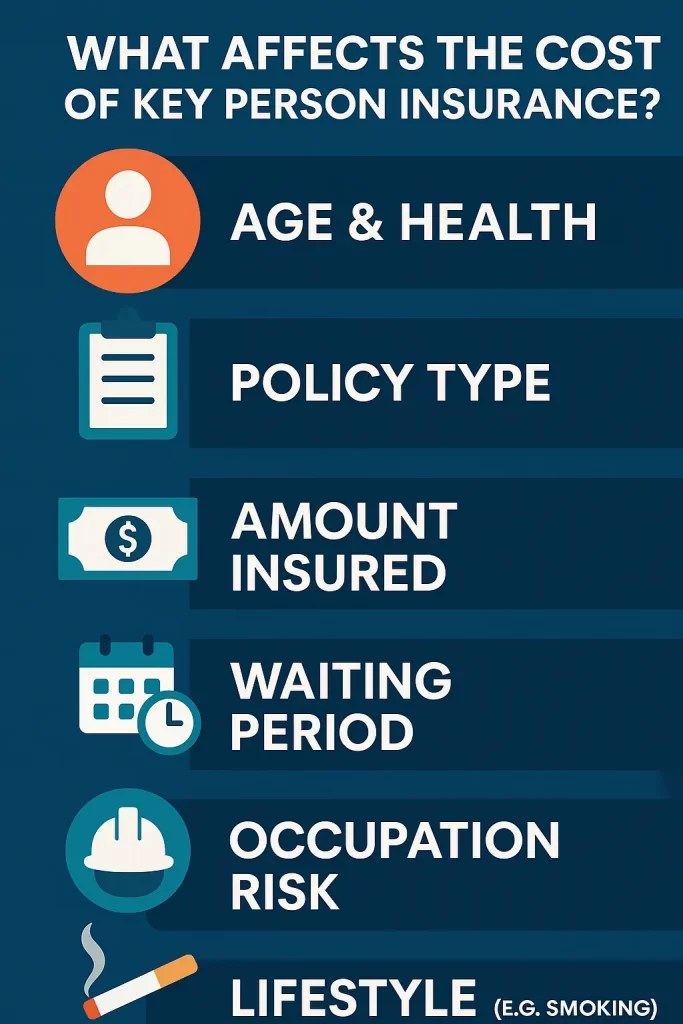Key Person Insurance in New Zealand (2025 Guide)
Table of Contents
ToggleHere’s a stark reality for New Zealand businesses: up to 70% of SME revenue can flow through just one or two individuals. Think about it. Your visionary founder. That top salesperson who brings in the lion’s share of clients. Or the technical lead whose specialised skills underpin your entire operation.
Now, imagine the unthinkable: that pivotal person is suddenly sidelined. We’re talking death, terminal or critical illness, or even permanent disability.
The fallout? It’s not just emotional. It’s a financial earthquake that can shatter your business:
- Revenue gaps emerge almost instantly. You’re scrambling to cover payroll and supplier invoices.
- Projects grind to a halt. Valuable intellectual property and client relationships sit idle without your expertise at the helm.
- Creditors lean in. They start questioning late loan and lease repayments, threatening penalty interest.
- Team morale plummets. The remaining staff are stretched thin, risking burnout themselves.
Sound terrifying? It is.
But here’s the kicker: Key Person Insurance in New Zealand turns this potential chaos into calm. It’s your vital financial safety net, delivering a single, crucial lump-sum payout when disaster strikes.
In this comprehensive guide, you’ll discover:
- Exactly what key person insurance is (and why it’s different).
- Who really needs it most in the New Zealand market?
- The step-by-step process of how it works.
- The game-changing benefits it delivers (beyond just a payout).
- What drives the cost of your premiums?
- The five costly mistakes you absolutely must avoid.
Ready to protect your business’s most valuable asset? Let’s dive in.
What Exactly Is Key Person Insurance? (And Why It’s Not What You Think)
At its core, key person insurance in New Zealand is a specialised, business-owned policy. Its sole purpose? To act as a financial safety net when someone critical to your company can no longer perform their role.
Now, here’s the crucial distinction:
Unlike personal life or health cover, where the individual owns the policy and proceeds flow to their estate, key person insurance is taken out by the business itself. Your company pays the premiums, maintains the policy, and, critically, is the
sole beneficiary of any payout.
When a covered event occurs, the insurer delivers a lump sum directly to your business. This means you maintain direct financial control over the funds. And get this: there are
no restrictions on how these funds are used. Maximum flexibility when you need it most. In New Zealand, ACC only covers accidental injury — not illness — so relying on it alone could leave your business exposed. That’s where key person insurance becomes essential.
What kind of events does it cover?
Standard events include the death of the key individual or a terminal illness diagnosis. But you can significantly enhance your protection with powerful riders:
- Critical Illness Rider: This triggers a payout if the key person suffers a specific medical event, like a heart attack or stroke. This helps bridge revenue gaps while they recover.
- Total and Permanent Disability (TPD) Add-on: A TPD add-on pays out if the insured individual can never return to their previous role due to permanent disability. These funds are vital for recruiting and training a replacement without straining day-to-day cash flow.
- Income Protection Extension: Many businesses choose this. It provides regular payments during periods of temporary incapacity. This is a lifesaver for small enterprises where even a few months of lost productivity can derail projects or client commitments.
Bottom line? Key Person Insurance in New Zealand is designed to offer financial stability when leadership or critical roles are suddenly lost. By layering these cover types, you create a bespoke risk-management solution tailored precisely to your company’s structure and financial obligations. This modular approach ensures your policy addresses a wide range of potential disruptions, making it a versatile tool for business resilience.
Who Absolutely Needs Key Person Insurance in New Zealand? (Is It You?)
Deciding if key person cover belongs on your risk-management checklist starts with one brutal question: Where would your business falter if a single individual were suddenly sidelined?
This isn’t just about who earns the most. It’s about who holds the critical threads of your operation. Many owners don’t realise how exposed they are until they explore Key Person Insurance and see how closely it’s tied to real operational risk.
Here are the roles that typically represent significant vulnerabilities:
-
- Founders & Visionaries: In many SMEs, the founder’s vision, industry contacts, and strategic insights are the primary drivers of new contracts and overall growth. Losing them can mean the difference between a temporary setback and a complete collapse in revenue. According to MBIE, over 97% of New Zealand businesses have fewer than 20 employees, with many relying on just one or two key people to drive revenue and manage operations.
- Your “Rainmakers” (Top Salespeople): Sales-driven organisations often concentrate risk in their top salespeople. These “rainmakers” bring in the bulk of contracts and hold deep relationships with key clients. An unexpected absence could stall negotiations, delay projects, or even lead to client defections. Key person insurance provides funds to engage interim sales support or explore new business channels, helping to keep the pipeline flowing.
- Specialist Consultants & Technical Leads: For businesses built on unique intellectual property or proprietary processes, specialists such as IT architects, lead developers, or creative directors are indispensable. If your operation hinges on one expert’s skills to design, build, or deliver products and services, ensuring that person can prevent critical gaps in expertise and decision-making.
- Companies with Significant Debt: Businesses carrying substantial debt—whether bank loans for equipment, commercial property mortgages, or investor-backed growth capital—may find lenders demanding cover on key roles as part of their loan covenants. In such cases, key person insurance not only safeguards cash flow but also satisfies creditor requirements, reassuring both banks and stakeholders of preparedness for the unexpected.
Even in larger teams, where multiple staff contribute to daily operations, it’s often one or two individuals who hold the threads together. Their sudden loss can strain cash flow, delay deliverables, and erode client trust faster than replacements can be recruited. Key person insurance in bridges this gap, providing the breathing room to regroup, retrain staff, or bring in external specialists without derailing growth.
When you recognise where your vulnerabilities truly lie, protecting those pivotal people becomes as essential as insuring your premises or equipment.
How Key Person Insurance Works: Your Step-by-Step Blueprint to Protection
Implementing key person cover follows a straightforward, step-by-step process designed to match your business’s risk profile and budget.
Here’s how it breaks down:
Step 1: Identify Your MVPs (Most Valuable People)
First things first: determine which individuals, if suddenly unavailable, would most jeopardise your operations. This might be a founding director whose industry insight drives strategy, a top salesperson whose network secures major contracts, or a technical lead whose expertise underpins your core products. Pinpointing these individuals ensures your cover is focused where it matters most.
Step 2: Choose Your Cover Types and The Right Sum Insured
Once your MVPs are identified, select the appropriate cover types and determine the sum insured. You can opt for a basic life-only policy (payout on death or terminal illness) or layer in critical illness and Total and Permanent Disability (TPD) options for broader protection. Many businesses also add an income-protection rider, which provides monthly benefit payments during any period of certified incapacity.
Pro Tip: Calculating the right payout amount involves a careful estimation of potential revenue losses, recruitment and training costs, and any debt obligations tied to that person’s role. Don’t underestimate your true exposure!
Step 3: The Underwriting Process (Don’t Skip This!)
With your cover structure defined, the process moves into underwriting. This typically begins with health and lifestyle questionnaires for the individuals being insured. For larger sums, insurers may request medical examinations—like blood tests or specialist reports—and financial documentation to confirm your business’s exposure.
The bottom line? Accurate disclosures are paramount. They ensure smoother claims processing and prevent future disputes, safeguarding the policy’s effectiveness when it’s most needed.
Step 4: Paying Your Premiums (and Unlocking Tax Benefits!)
Once underwriting is complete and your application is approved, you will begin paying premiums, typically on a monthly or annual basis. Here’s some good news for New Zealand businesses: premiums paid for key person cover are generally tax-deductible as a business expense under New Zealand tax rules. This provides an added financial incentive. You’ll receive renewal notices each year, offering the opportunity to review cover levels and adjust them as your company grows and its needs evolve.
IRD guidance states that key person insurance premiums are deductible only when primarily used to replace lost income and not deductible if the policy’s primary purpose is to repay a loan or fund a share buyout. Likewise, any payout used to replace revenue can be taxable business income
Step 5: Submitting a Claim (When Disaster Strikes)
Finally, if a covered event occurs—whether it’s the unfortunate passing of a key individual or a qualifying critical illness—your business submits a claim with the insurer, accompanied by the necessary medical and corporate documentation. After the assessment, the insurer releases the lump-sum payout directly to your business.
Remember: there are no restrictions on how these funds are allocated. You can immediately cover lost profits, hire interim staff, service debts, or shore up other critical expenses without delay. This flexibility assures you control when you need it most.
5 Game-Changing Benefits Key Person Insurance Delivers (Beyond Just a Payout)
You might be wondering what the real payoffs of key person insurance are, beyond simply receiving a lump sum. Here’s the deal: this specialised cover provides far-reaching advantages that can fundamentally alter your business’s ability to navigate unforeseen challenges.
1. Maintain Liquidity & Cash Flow (No More Scrambling)
When a vital team member is suddenly unable to work, the immediate concern is often plugging the financial hole their absence creates. Key Person Insurance ensures your business keeps running without financial disruption.
With key person insurance in place, a lump-sum payout directly offsets any lost revenue. This provides the cash flow cushion needed to cover operating costs, pay staff, and keep suppliers on side. Crucially, this buys your business time to recruit and train a replacement
without tapping into precious cash reserves.
2. Meet Debt Obligations with Confidence (Keep Creditors Happy)
Meeting existing debt obligations becomes far less stressful when insurance proceeds can be earmarked for loan repayments or lease payments. Rather than scrambling to renegotiate bank covenants under pressure, you can reassure creditors that you remain creditworthy, maintaining favourable terms and avoiding penalty interest or forced asset sales.
3. Swift Recruitment & Onboarding (Plug Those Gaps FAST)
Securing specialised skills on short notice comes at a premium. The released funds from key person insurance allow your business to engage recruitment agencies, offer competitive interim contracts, or fast-track relocation packages for new hires. This ensures that knowledge gaps are plugged swiftly and efficiently
without draining working capital, leading to a smoother, less disruptive transition during a critical period.
4. Preserve Client Relationships & Service Levels (Protect Your Reputation)
Your clients—and the relationships built with them—are a priceless asset. Key person cover helps keep projects on track, even if a familiar face is out of action. By funding temporary expert support or incentivising existing staff to ramp up, you protect delivery timelines. This also demonstrates robust continuity plans to clients, which is vital for protecting brand reputation and fostering sustained growth.
5. Strategic Flexibility in Crisis (Turn Adversity into Opportunity)
The most significant advantage of key person insurance is the flexibility it provides for strategic response. Having liquid resources at your disposal turns a potential crisis into a moment of calculated reinvention. You can decide to restructure teams around emerging opportunities, invest in automation to reduce future dependency on individual experts, or pay down high-interest debt. Rather than reacting in panic, your business can pivot confidently, knowing its financial foundation is secure.
What Drives the Cost of Your Key Person Cover? (Understanding Your Premium)
What factors actually influence your premium? It’s not as simple as many might think. Understanding these elements is crucial for finding the optimal balance between comprehensive protection and affordability.
1. Age and Health of the Insured (The Big One)
The first thing insurers look at is the age and health of the person being protected. Younger, fitter individuals with clean medical histories typically secure the lowest premiums. Why? Statistically, they are less likely to make a claim. As a key person ages or if they have pre-existing conditions—such as high blood pressure, diabetes, or a history of serious illness—insurers factor in a higher risk of payout and pass that cost on as increased rates.
2. Amount of Cover & Policy Term (More Protection, More Cost)
The amount of cover chosen and the length of the policy term play a significant role in determining cost. A policy that promises a larger lump sum or extends over a longer period represents a bigger commitment for the insurer so that the premium will be higher. For example, insuring someone for $1 million over 20 years will cost significantly more than covering them for $500,000 over 10 years.
3. Type of Cover (Life, Critical Illness, TPD, Income Protection)
The type of cover added also affects pricing. Basic life-only policies are the most cost-effective. However, layering in critical illness or total and permanent disability (TPD) benefits can increase the premium markedly. Why? These riders guarantee payouts for specific medical events—such as heart attacks, strokes, or permanent loss of function—which insurers price to reflect their likelihood and potential claim size.
4. Occupation and Lifestyle Factors (Your Job Matters)
A key person’s occupation and lifestyle further influence loadings. Roles that involve hazardous duties—such as construction site managers, heavy vehicle drivers, or mine engineers— attract extra charges. Similarly, high-risk hobbies such as skydiving or scuba diving, or even daily habits like smoking, can result in premium surcharges.
5. Waiting Period & Benefit Period (The Trade-Off)
The waiting period (the time before benefits kick in) and the benefit period (the duration of payouts) provide levers to adjust the premium. Opting for a more extended waiting period—say, 90 days instead of 30—can lower costs, as can choosing a shorter benefit term. However, this is the catch: these savings must be weighed against the risk of funding a gap internally if the key person is unable to work.
Bottom line? These factors influence every quote for Key Person Insurance in New Zealand, so it pays to compare providers carefully.
Because each factor interacts differently depending on your business’s circumstances, the fastest way to find the sweet spot between cover and cost is to compare multiple quotes side by side.
Key Person Insurance vs. Shareholder Protection: A Clear Distinction You Need to Know
Many business owners confuse key person insurance with shareholder protection. But they serve very different, yet equally vital, purposes. Understanding this crucial difference is essential for building a comprehensive risk management strategy.
Here is a clear comparison of the two:
| Aspect | Key Person Insurance | Shareholder Protection |
| Purpose | Covers business costs (lost revenue, recruitment, debt servicing) when a key employee is incapacitated or dies. | Provides funds for remaining shareholders to buy out the deceased’s or departing owner’s equity. |
| Beneficiary | The business. | The surviving shareholders. |
| Best For | SMEs whose operations rely on specific individuals (founders, rainmakers, specialists). | Closely held companies, partnerships or family businesses aiming to maintain ownership balance and control. |
Avoid These 5 Costly Mistakes When Securing Your Cover
Warning: Even the most prudent business owners can slip up when arranging key person cover. By steering clear of these common errors, you can ensure that your policy delivers the protection you actually need. Setting up Key Person Insurance in New Zealand correctly means avoiding these common mistakes that could weaken your protection.
1. Underestimating Your True Exposure (It’s More Than Just Salary)
It’s easy to think that replacing a key person merely costs their annual salary. Wrong. The reality is far more complex and expensive. You’ll face recruitment fees, onboarding and training expenses for a new hire, potential overtime payments for existing staff stretched to cover the gap, and the ripple effect of stalled projects or delayed deliveries. These hidden costs can quickly accumulate.
The takeaway: Factor in all these comprehensive costs when calculating the sum insured so the payout truly bridges the entire financial and operational gap.
2. Relying on Personal Policies (A Critical Error)
A critical error is to depend on personal life or health insurance policies to keep your business afloat. Personal policies pay benefits to an individual or their estate—
not directly to your company. If your business depends on those proceeds, it could find itself financially short when it matters most, as the funds may not be immediately accessible or legally designated for business use.
The rule of thumb: Always take out a business-owned key person policy, ensuring any lump-sum payout is directed straight to the operations of your company.
3. Skipping Regular Reviews (Your Business Evolves)
Businesses are dynamic entities; revenues grow, teams expand, and roles shift over time. A cover level that sufficed three years ago may leave your business dangerously underprotected today. This oversight can result in inadequate coverage when a claim is eventually filed.
The pro tip: Build an annual review into your business calendar (for example, every annual renewal) to revisit sums insured, benefit types, and policy terms. This ensures the policy remains relevant and effective as needs change.
4. Insuring Only the Owner (Don’t Overlook Other MVPs)
While a founder’s departure can be devastating, other staff members can be equally critical to your business’s day-to-day operations and long-term viability. This could be a lead developer who oversees the codebase, an operations manager who keeps supply chains running smoothly, or a specialised expert. Focusing exclusively on the business owner is a common, narrow perspective.
The smart move: Identify all high-impact roles and consider a single policy that covers multiple key people, rather than overlooking critical blind spots in your coverage.
5. Overlooking Exclusions, Waiting Periods & Benefit Limits (Read the Fine Print!)
Fine print matters. Critical illness riders often list specific conditions that trigger payouts, and income protection add-ons may have waiting periods of 30, 60, or even 90 days before benefits begin. It is essential to understand any waiting periods, caps on lump sums or monthly payments, and exclusions that could render a claim invalid.
The hard truth: A small premium saving today, achieved by overlooking these details, could mean a denied claim tomorrow.
Your Action Plan: How to Choose & Apply for the Right Policy (Step-by-Step)
Ready to act? By proactively addressing the pitfalls outlined and following a structured approach, you can design a key person policy that effectively safeguards cash flow, client relationships, and long-term strategy, keeping your business resilient in the face of challenges that arise.
Here’s your step-by-step guide to choosing and applying for the right policy:
1. Assess Your Risks (Get Real About Vulnerabilities)
First, convene your leadership team. This collaborative exercise ensures a comprehensive understanding of your business’s vulnerabilities. Together, list all roles whose absence would disrupt cash flow, client delivery, or loan repayments. This strategic approach leads to a more robust and accurate risk assessment.
2. Calculate Cover Amount (Don’t Leave Money on the Table)
Next, estimate potential lost profits over a realistic recruitment and training period for each identified key person. Crucially, include any outstanding debts, leases, or contractual obligations tied to that person’s role. This explicit inclusion ensures a comprehensive financial calculation, preventing the common mistake of underestimating exposure and ensuring adequate coverage. When applying for Key Person Insurance, the sum insured and policy duration must align with the financial impact of losing key people.
3. Compare Quotes (The Smart Way to Save)
To find the best fit, use a side-by-side comparison tool, such as the one available on Compare Life Cover, which allows you to adjust the sum insured, term length, and waiting periods to see real-time premium changes. The best part? There are no broker fees or hidden charges, ensuring complete transparency throughout the comparison process.
4. Complete Underwriting (Be Honest, Be Thorough)
Once a policy is chosen, the underwriting process begins. This involves filling out health and lifestyle questionnaires for each insured individual. For higher cover amounts, be prepared to schedule any required medical exams or professional valuations. Reiterating the need for accurate and complete underwriting ensures that this critical step for valid claims is handled correctly.
5. Review & Confirm (The Final Check)
Before activating the policy, a meticulous review is essential. Double-check for exclusions, benefit caps, waiting periods, and premium stability clauses to ensures you understand the terms. It is also vital to ensures your business is listed as the policy owner and that payout beneficiaries are correctly designated. This final safeguard helps prevent future disputes or misdirected payouts.
6. Activate & Monitor (Set It and Forget It? Not Quite.)
Finally, sign the policy documents and set up premium payments. This is not a one-time event, but an ongoing process. Note renewal dates in your calendar and plan regular reviews to keep cover aligned with evolving business needs. This ensures the policy remains relevant and effective in the long term.
Your Top Key Person Insurance FAQs
Here are quick answers to some of the most frequently asked questions about key person insurance:
Q: How is Key Person Insurance in New Zealand different from personal life insurance?
A: Unlike personal life insurance, Key Person Insurance is owned by the business and pays out to the company, not to an individual or their estate.
Q: Can I insure more than one key person?
A: Yes, most insurers allow businesses to cover multiple individuals under a single policy, with each person having their own specified sum insured.
Q: Are premiums tax-deductible?
A: Generally, premiums paid by a business for key person cover are deductible as a business expense. However, it is always advisable to check with an accountant to confirm how this applies to a specific business structure.
Q: How quickly are claims paid?
A: Death and terminal illness claims are typically settled within days of receiving all required documentation. Critical illness or TPD (Total and Permanent Disability) claims may take longer to process, depending on the complexity of the medical reviews.
Q: What if the insured key person leaves the business?
A: Businesses can usually transfer the cover to a replacement individual or surrender the policy. It is important to always notify the insurer of staffing changes and review the cover accordingly to ensure continued protection.
Q: Do I need to undergo medical exams for all policies?
A: It depends on the sum insured. Smaller cover amounts often require only a health questionnaire, while larger sums typically trigger medical examinations or specialist reports to assess risk more thoroughly.
Final Call to Action: Lock in Your Business’s Safety Net Today!
The future of your business could depend on just one person. Don’t leave it to chance. Key Person Insurance in New Zealand provides the backup plan every smart Kiwi company needs.
👉 Compare Key Person Insurance in New Zealand now
Ready to secure your business’s resilience?
Latest Post
- Life Insurance for Senior Citizens in NZ: The 2025 Master Guide
- AIA’s Specialist and Testing Support – New Health Benefit Explained
- How Much Life Insurance in NZ Do Kiwis Need? 2025 Expert Guide
- Life Insurance vs Mortgage Protection in NZ: Key Differences
- Best Life Insurance Policies in NZ 2025: Expert Kiwi Guide





